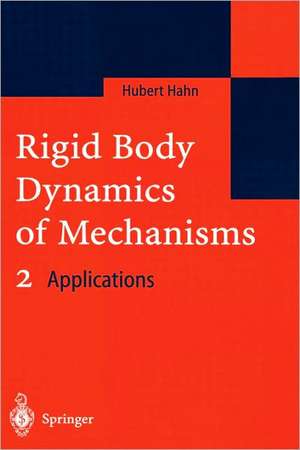Rigid Body Dynamics of Mechanisms 2: Applications
Autor Hubert Hahnen Limba Engleză Hardback – iul 2003
| Toate formatele și edițiile | Preț | Express |
|---|---|---|
| Paperback (1) | 2106.37 lei 43-57 zile | |
| Springer Berlin, Heidelberg – 30 noi 2010 | 2106.37 lei 43-57 zile | |
| Hardback (1) | 2112.85 lei 43-57 zile | |
| Springer Berlin, Heidelberg – iul 2003 | 2112.85 lei 43-57 zile |
Preț: 2112.85 lei
Preț vechi: 2576.65 lei
-18% Nou
Puncte Express: 3169
Preț estimativ în valută:
404.35€ • 420.58$ • 333.81£
404.35€ • 420.58$ • 333.81£
Carte tipărită la comandă
Livrare economică 14-28 aprilie
Preluare comenzi: 021 569.72.76
Specificații
ISBN-13: 9783540022374
ISBN-10: 3540022376
Pagini: 684
Ilustrații: XVII, 665 p.
Dimensiuni: 155 x 235 x 42 mm
Greutate: 1.13 kg
Ediția:2003
Editura: Springer Berlin, Heidelberg
Colecția Springer
Locul publicării:Berlin, Heidelberg, Germany
ISBN-10: 3540022376
Pagini: 684
Ilustrații: XVII, 665 p.
Dimensiuni: 155 x 235 x 42 mm
Greutate: 1.13 kg
Ediția:2003
Editura: Springer Berlin, Heidelberg
Colecția Springer
Locul publicării:Berlin, Heidelberg, Germany
Public țintă
ResearchCuprins
1. Introduction.- 2. Model equations in symbolic DAE and DE form.- 3. Planar models of an unconstrained rigid body.- 4. Planar models of a rigid body under absolute constraints.- 5. Planar models of two rigid bodies under constrained motion.- 6. Spatial models of an unconstrained rigid body.- 7. Spatial models of a rigid body under constrained motion.- 8. Spatial mechanisms with several rigid bodies.- A. Appendix.- A.1 Alternative representation of the spring and damper forces of Section 3.2.- A.2 Auxiliary computations and results associated with the mechanism of Section 8.3.- A.2.1 Explicit form of the constraint equations of the massless links.- A.2.2 Coefficients of the kinematics of the electrical drives.- A.2.3 Computation of the transformation matrix of the forces of the electrical drives.- A.3 Auxiliary computations associated with the example of Section 8.4.- A.3.2 Auxiliary computations used in Section 8.4.9.- References.- List of Figures.
Recenzii
From the reviews:
"The second volume, subtitled Applications, begins with a chapter summarizing the methodology for deriving the governing DAEs for a general mechanical system and mapping these into DEs. … The book has a number of nice features. … Multiple and comprehensive illustrations are provided throughout the manuscript, ranging from very simple diagrams to illustrate the basic concepts (such as a moment vector) to photographs and engineering drawings of complex machinery … . the manuscript makes for a desirable reference work in any mechanician’s library." (Inna Sharf, Mathematical Reviews, 2005 e)
"The second volume, subtitled Applications, begins with a chapter summarizing the methodology for deriving the governing DAEs for a general mechanical system and mapping these into DEs. … The book has a number of nice features. … Multiple and comprehensive illustrations are provided throughout the manuscript, ranging from very simple diagrams to illustrate the basic concepts (such as a moment vector) to photographs and engineering drawings of complex machinery … . the manuscript makes for a desirable reference work in any mechanician’s library." (Inna Sharf, Mathematical Reviews, 2005 e)
Textul de pe ultima copertă
The second volume of Rigid Body Dynamics of Mechanisms covers applications via a systematic method for deriving model equations of planar and spatial mechanisms. The necessary theoretical foundations have been laid in the first volume that introduces the theoretical mechanical aspects of mechatronic systems. Here the focus is on the application of the modeling methodology to various examples of rigid-body mechanisms, simple planar ones as well as more challenging spatial problems. A rich variety of joint models, active constraints, plus active and passive force elements is treated. The book is intended for self-study by working engineers and students concerned with the control of mechanical systems, i.e. robotics, mechatronics, vehicles, and machine tools. The examples included are a likely source from which to choose models for university lectures.
Caracteristici
Discussion of engineering applications (robots, airplanes) Systematic approach for deriving model equations Enables the reader to handle modern general purpose rigid body programs











